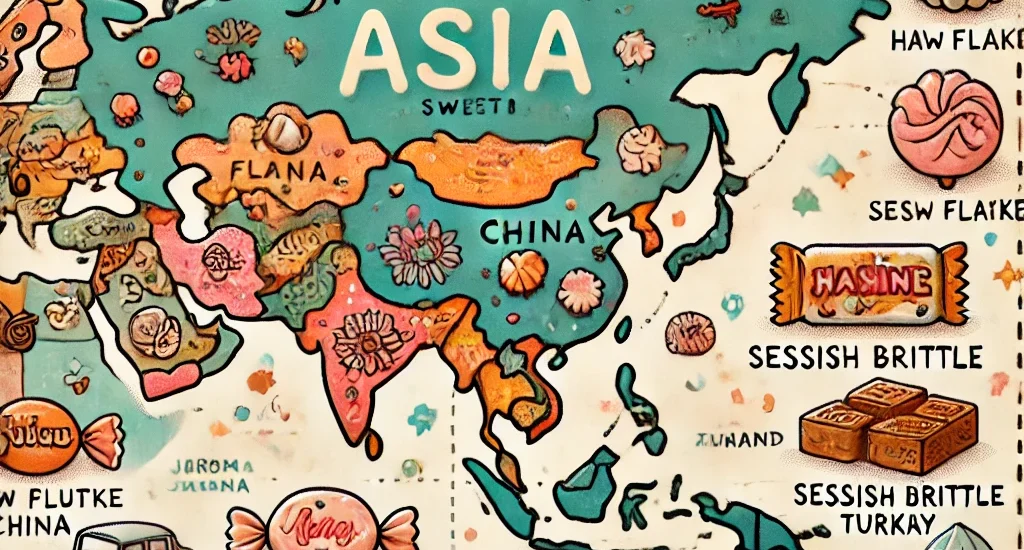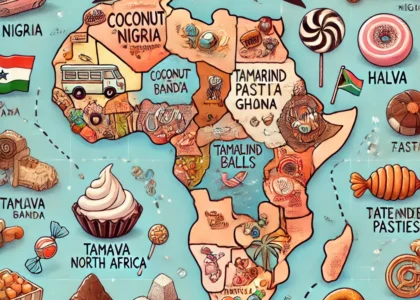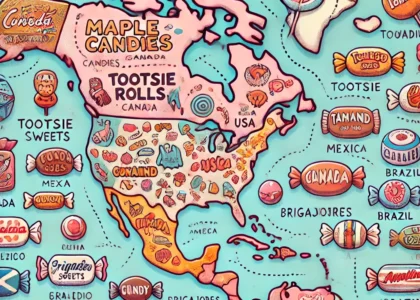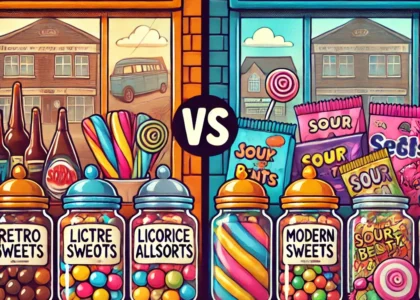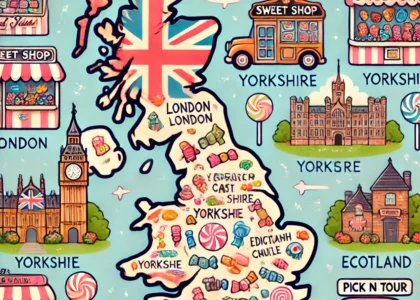Introduction: A Continent of Flavorful Memories
Asia is a continent rich in tradition, culture — and unforgettable sweets. From the chewy rice treats of East Asia to the vibrant spices of South Asia, and the dried fruit delights of the Middle East, Asia’s retro confections offer not only flavor but a strong sense of place and memory. These candies and snacks aren’t just sugary — they reflect family traditions, street food culture, and generational rituals.
This article takes you on a nostalgic tour of the most iconic retro sweets across Asia — the ones sold outside schools, eaten during festivals, or shared during long train rides with cousins.
Japan: Ramune Candy and Konpeitō
Japanese retro sweets are whimsical, precise, and unforgettable in design.
- Ramune Candy – fizzy, soda-flavored tablets named after the Ramune drink.
- Konpeitō – star-shaped sugar candies introduced centuries ago by the Portuguese.
- Hi-Chew – fruity, chewy taffies that feel like a mix between gum and candy.
- Sakuma Drops – classic hard candies in metal tins (made famous in “Grave of the Fireflies”).
- Botan Rice Candy – chewy rice sweets wrapped in edible rice paper.
Sold in convenience stores, train stations, and festivals, these treats are part of daily life and anime nostalgia alike.
China: White Rabbit and Haw Flakes
Chinese retro sweets blend traditional herbal flavors with creamy indulgences.
- White Rabbit – creamy, milky candy wrapped in edible rice paper.
- Haw Flakes – tart discs made from the hawthorn fruit, often eaten after meals.
- Sachima – a light, sweet fried flour snack bound with syrup (like a Chinese Rice Krispie treat).
- Dragon Beard Candy – handmade spun sugar threads filled with peanuts and sesame.
- Preserved Plum Candy – salty, sour, and sweet — a complex acquired taste.
Often bought from street vendors or school tuck shops, these are linked to both childhood and traditional medicine.
South Korea: Saecom Dalcom and Apollo
Korean retro sweets offer a blend of playful packaging and intense flavors.
- Saecom Dalcom – sour chewy candies, Korean predecessors to sour gummies.
- Apollo – tiny tubes filled with flavored goo, eaten like toothpaste.
- MyChew – similar to Hi-Chew but with Korean-style fruit flavoring.
- Ggultarae (Honey String Candy) – traditional hand-pulled honey and maltose threads.
- Banana Milk Candy – based on Korea’s famous banana milk drink.
Often found in “dallejang” (small corner shops), these were a daily ritual for Korean schoolkids.
India: Parle Melody and Aam Papad
Indian sweets are as diverse as its regions — sweet, spicy, tangy, and layered.
- Parle Melody – chocolate-filled caramel that spawned the famous slogan “Melody Itni Chocolaty Kyun Hai?”
- Aam Papad – sun-dried mango leather, sweet and tart.
- Churan Goli – digestive tamarind balls rolled in masala and salt.
- Kismi Toffee Bar – cardamom-flavored chewy toffee wrapped in foil.
- Phantom Sweet Cigarettes – chalky, sugary sticks in red packaging.
These sweets were usually bought from “kirana” stores and eaten during summer holidays or between cricket matches.
Pakistan: Ding Dong and Imli Candy
Pakistani retro sweets have rich flavors with bold spice notes.
- Ding Dong Bubble Gum – bright pink gum with cartoon mascots.
- Imli Candy – tamarind and chili wrapped in clear cellophane.
- Toffee Apple – hard, sugary candies shaped like tiny apples.
- Cocomo Biscuits – cream-filled cookies, often mistaken for a candy treat.
- Pop-it – lollipops with fizzy powder or gum centers.
Available at roadside carts, general stores, and “dukaan,” these were pocket-money staples.
Thailand: Tamarind Candy and Sugus
Thai sweets are punchy, often combining sweet, salty, and spicy elements.
- Tamarind Candy – chewy or dried, often coated in chili sugar.
- Sugus – fruity, chewy squares originally Swiss, now very Thai.
- Thai Milk Tablets – creamy, chalk-like candies shaped like cows or stars.
- Fruit Jellies – often individually wrapped and in tropical flavors.
- Lobo Jelly Cups – tiny gelatin pots with fruit syrup.
Street vendors and 7-Elevens alike stock these — still a favorite among kids and adults.
Philippines: Mik-Mik and Flat Tops
Filipino retro sweets balance sugar with humor and a sense of fun.
- Mik-Mik – flavored powdered milk sold in sachets, often snorted like candy dust.
- Flat Tops – circular milk chocolates wrapped in foil.
- Curly Tops – similar to Flat Tops, but shaped like cupcakes.
- Haw Flakes – borrowed from China, but a staple in Filipino childhood.
- White Rabbit – imported but beloved.
Sold in sari-sari stores or school canteens, these treats are always tied to playtime.
Vietnam: Kẹo Dừa and Rice Paper Candy
Vietnamese sweets often use coconut and rice as a base:
- Kẹo Dừa (Coconut Candy) – chewy coconut caramels from Ben Tre province.
- Rice Paper Candy – sheets filled with coconut, sesame, and condensed milk.
- Tamarind Balls – sticky-sweet with a hint of chili.
- Tofu Skin Candy – thin sweet wrappers layered with caramelized sugar.
- Lotus Seed Candies – lightly sweet and floral.
Many are sold in markets or handmade for Tết (Lunar New Year) celebrations.
Indonesia: Kopiko and Permen Jahe
Indonesia’s sweets are deeply tied to coffee, spices, and kampung (village) life.
- Kopiko – coffee-flavored hard candy, now world-famous.
- Permen Jahe (Ginger Candy) – sweet-spicy throat soothers that double as treats.
- Tamarind Candies – wrapped in brown paper, tangy and earthy.
- Permen Susu – sweetened condensed milk hard candies.
- Choki Choki – chocolate paste in a squeezable tube.
Sold at warungs and school gates, these sweets defined 90s Indonesian youth.
Malaysia & Singapore: White Rabbit and Haw Flakes
Much like their neighbors, these countries share similar Chinese-influenced retro treats.
- White Rabbit & Haw Flakes – still sold widely in Asian supermarkets.
- Sticky Candy Rolls – hand-pulled sugar shaped into bright swirls.
- Biskut Aiskrim (Ice Cream Biscuits) – pastel biscuits with colorful icing mounds.
- Tamarind Sticks – sour, pulpy tamarind molded onto skewers.
- Gem Biscuits – small round cookies topped with colorful icing (also loved in the UK).
These are found in “kopitiams” (coffee shops), mama shops, or school tuck shops.
Iran: Gaz and Nabat
Iran’s sweets reflect centuries of Persian confectionery tradition.
- Gaz – Persian nougat with pistachios and rosewater.
- Nabat – saffron-infused rock sugar on sticks, often stirred into tea.
- Lavashak – fruit leather made from sour plums or pomegranate.
- Sohan – crispy saffron brittle with cardamom and almonds.
- Toot – sweet marzipan shaped like mulberries.
Many of these are tied to Nowruz (Persian New Year) and family hospitality.
Central Asia (Uzbekistan, Kazakhstan, etc.): Dried Fruit and Sugar Nuts
Retro sweets in Central Asia blur the line between snack and dessert.
- Candied Melon and Pumpkin – sweetened and sun-dried.
- Sugar-coated Chickpeas – sold in colorful bags at markets.
- Chak-Chak – fried dough bites stuck together with honey syrup.
- Barfi-style milk sweets – often homemade.
- Rock Sugar – served with tea in ornate bowls.
These are often part of communal gatherings and traditional ceremonies.
Conclusion: The Sweet Language of Asia
Across Asia’s immense diversity, one thing remains consistent — the role of sweets in memory-making. Whether it’s pulling a Hi-Chew from a schoolbag in Tokyo or sharing a piece of Lavashak under a mulberry tree in Tehran, retro candies connect generations and celebrate culture.
These aren’t just treats — they’re rituals, rewards, and symbols of simpler times. In an era of high-tech snacking, Asia’s retro sweets still prove that sometimes the most meaningful flavors come in small, simple packages.

